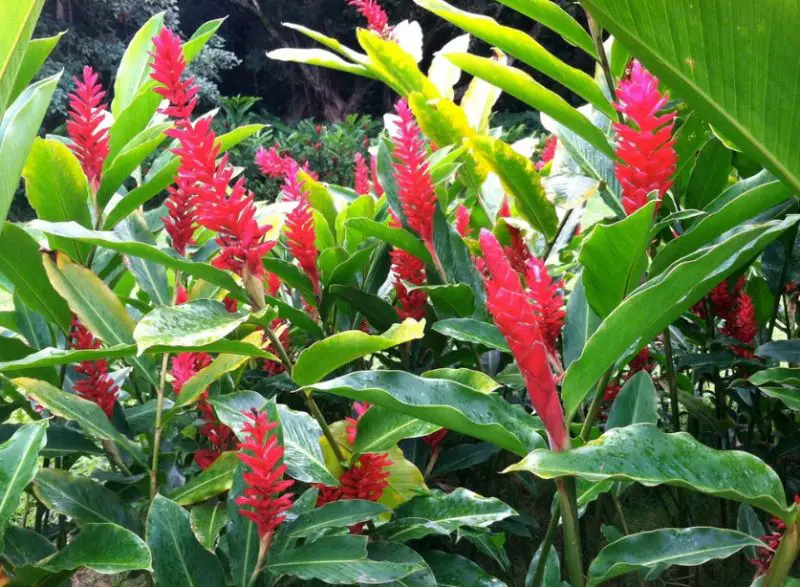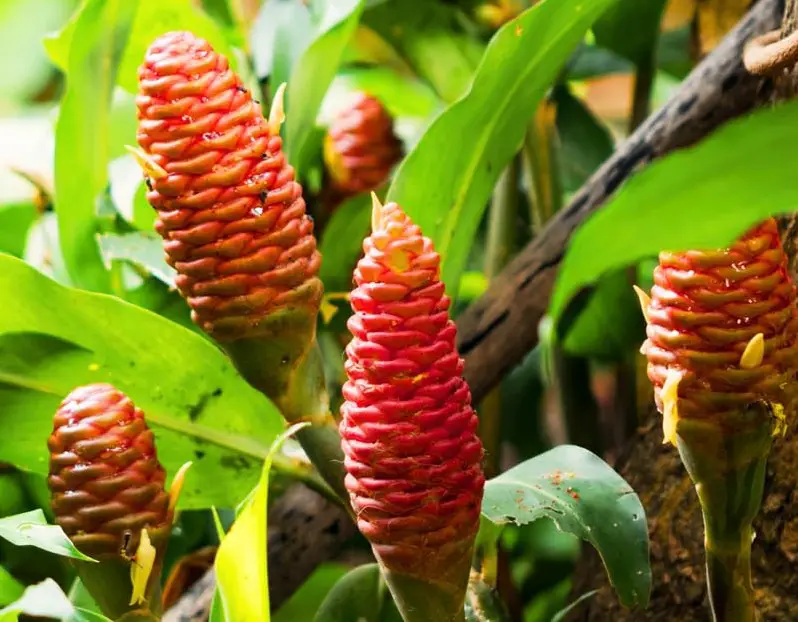The Awapuhi plant, also known as shampoo ginger, is gaining popularity for its unique aesthetic and practical uses. Scientifically referred to as Zingiber zerumbet, this plant is a member of the ginger family (Zingiberaceae) and shares its lineage with turmeric (Curcuma longa) and common ginger (Zingiber officinale). Native to Asia and Australia, the plant has been naturalized in places like Hawaii, where it’s not only valued for its beauty but also for its medicinal and cosmetic applications.
In this detailed guide, we’ll cover everything you need to know about growing and caring for this fascinating plant.
What is the Awapuhi Plant?

Shampoo ginger, also known as red pinecone ginger or Awapuhi kuahiwi, is a perennial plant known for its eye-catching red, pinecone-shaped flowers. The plant has earned its nickname due to the rich, fragrant juice that can be squeezed from its mature flowers, traditionally used as a natural shampoo and conditioner in places like Hawaii.
While the plant may appear exotic, it’s relatively easy to grow, and its benefits extend far beyond its ornamental value. Shampoo ginger has been used by indigenous peoples for hair care and medicinal purposes for centuries. Despite its tropical origins, it can be successfully grown in various climates with the right care.
Plant Overview
- Botanical Name: Zingiber zerumbet
- Common Names: Shampoo ginger, Awapuhi, Red pinecone ginger
- Plant Type: Perennial
- Family: Zingiberaceae
- Native Area: Asia and Australasia
- Mature Size: Up to 4 feet tall
- Sun Exposure: Full sun to partial shade
- Water Requirements: Regular watering, especially during the growing season
- Soil Type: Well-draining, fertile
- Hardiness Zones: USDA 8-10
- Pests and Diseases: Spider mites, aphids, cardamom root grub
- Maintenance Level: Low
Characteristics of Awapuhi (Shampoo Ginger)
The shampoo ginger plant is unique in appearance and structure. It grows to about 4 feet tall with vibrant green leaves and red pinecone-like flowers that grow close to the ground. These flowers are initially green but turn a striking red as they mature, filled with fragrant juice.
The rhizomes of the plant (thick, underground stems) are similar to those of ginger and turmeric, storing energy for the plant to survive through its dormant phase in fall and winter. The juice from the red cones is used for hair care, while the rhizomes are also used in food flavoring and cosmetic products.
How to Grow Awapuhi (Shampoo Ginger)
While shampoo ginger may seem like a complex plant to grow, it is relatively low-maintenance. With the proper care and environment, you can easily cultivate this tropical beauty at home.
Light Requirements
Shampoo ginger thrives in full sun to partial shade. Ideally, it needs at least six hours of sunlight daily. If grown indoors, place it near a south-facing window for optimal light exposure. Without enough sunlight, the plant may drop its leaves or fail to flower. It’s essential to provide adequate light, especially if using the plant as an indoor houseplant.
Watering Needs
Awapuhi requires consistently moist soil but should never be waterlogged. Water the plant regularly, ensuring that the soil remains damp but not soggy. It’s essential to water more frequently during the flowering period, as the plant needs extra moisture to support the development of its vibrant blooms.
During the plant’s dormant season (fall through early spring), reduce watering to avoid overhydration. Once the plant starts showing signs of new growth in spring, you can resume regular watering.
Soil Conditions
Shampoo ginger prefers fertile, well-draining soil with a slightly acidic to neutral pH (between 5.7 and 8.0). If planting in poor soil, amend it with organic matter such as compost or cow manure to improve fertility. In areas where shampoo ginger may become aggressive or invasive, it’s best to grow it in a container with rich potting soil to keep its growth in check.
Temperature and Hardiness
The ideal temperature range for shampoo ginger is between 71-77°F (22-25°C). While the plant can tolerate short-term freezes, it’s best to provide protection if frost is expected. In USDA hardiness zones 8b through 10a, the plant is winter hardy, but in colder climates, consider bringing it indoors or covering the rhizomes with mulch to overwinter them safely.
Fertilizing
Awapuhi typically does not require much additional fertilizer. Instead of using chemical fertilizers, refresh the soil annually by adding a layer of compost or organic matter around the base of the plant. This will help replenish nutrients and promote healthy growth.
Maintenance and Care
Once established, shampoo ginger requires minimal maintenance. As the plant matures, its flowers will change from green to red, signaling that it’s time to harvest the shampoo juice.
Pruning and Deadheading
To encourage continuous flowering and keep the plant healthy, remove spent flowers by cutting the stems close to the base. The leaves and stems can be used as flavorings for food, while the juice from the flowers can be harvested for shampoo.
Controlling Growth
In certain climates, shampoo ginger can become aggressive. To prevent this, consider dividing the rhizomes and planting them in containers. Regularly check the plant’s growth and divide the rhizomes every few years to keep it manageable.
Propagation
The easiest way to propagate shampoo ginger is through rhizome division. In early spring, when the plant begins to show new growth, dig up the rhizomes and divide them into sections. Each section should have at least one “eye” or growing point.
Replant the rhizomes in a new location or container, ensuring they are in nutrient-rich, well-draining soil. Water them thoroughly and provide adequate sunlight to encourage growth.
Harvesting Awapuhi

One of the most rewarding aspects of growing shampoo ginger is harvesting the liquid from its mature red flowers. To do this, wait until the flowers have turned a deep red, then gently squeeze the pinecone-shaped blooms to extract the fragrant juice. This liquid can be used as a natural shampoo and conditioner.
You can harvest the juice throughout the growing season or wait until the end of the season to collect a larger quantity. Store the harvested liquid in a sealed container and freeze it to preserve it for later use.
Common Pests and Problems
While shampoo ginger is relatively resilient, it can occasionally fall victim to a few pests and environmental issues.
Spider Mites
Spider mites are tiny, sap-sucking pests that can cause damage to the plant’s leaves. Look for dusty patches or small webs on the undersides of leaves. To control spider mites, introduce natural predators like lacewings or ladybugs, or apply insecticidal soap sprays.
Aphids
Aphids feed on plant sap and can weaken your shampoo ginger plant. Check for these pests near the leaf nodes and on the undersides of leaves. To control aphids, you can use a strong stream of water to dislodge them or apply neem oil or insecticidal soap.
Cardamom Root Grub
Cardamom root grubs feed on the plant’s rhizomes, stunting its growth. These pests lay eggs on the lower leaves, and the larvae feed on the roots. Beneficial nematodes or manual removal can help control these grubs.
Conclusion
Shampoo ginger (Zingiber zerumbet) is a versatile, low-maintenance plant that offers aesthetic beauty and practical benefits. Whether grown for its ornamental value, its juice for hair care, or its culinary uses, this tropical plant is a must-have for gardeners looking to add a unique and exotic element to their collection.
You may successfully cultivate this interesting plant and take advantage of its many benefits by following our comprehensive instruction on cultivating and taking care of Awapuhi. Shampoo Ginger is guaranteed to become the focal point of your yard or house.







I have been growing awapuhi since late February, early March in pots (I live in zone 6a). While they are getting huge and sprouting new sprouts I have yet to see a flower. What am I doing wrong?